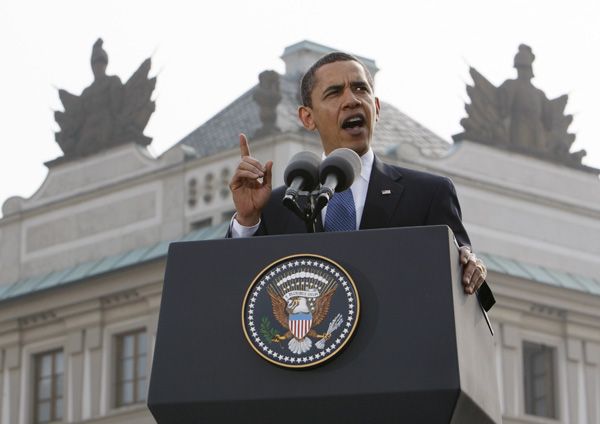No First Use: Don’t Do It, Mr. President!
Posted on

Obama speaks at Prague
Don’t do it, Mr. President. Don’t promise that the US will never be the first to use nuclear weapons. And don’t give credence to that “hair trigger” fol-de-rol. De-alerting and no-first-use might appear to be good stabilizing measures, but in practice they seem sure to reduce security, undercut stability, and encourage Russia, China, and, eventually, the US to build larger nuclear arsenals.
A few weeks ago a White House official announced that the president was considering taking action soon on additional ways to reduce the role of nuclear weapons in US defense planning. Then recently the Washington Post reported that two “golden oldies” were being considered: taking strategic nuclear missiles off “hair trigger” alert, and announcing a “no first use” policy.
These two items share a couple of important properties: neither is verifiable, and each offers a strong incentive to cheat. If all major nuclear powers agreed to take these measures, and if each power trusted the others to live up to the agreement, then safety and stability might be promoted by promising “no first use” and letting hair entangle the nuclear trigger. But, as in many Utopian schemes for peace, if the governments had that much trust in each other they probably wouldn’t need the agreement in the first place.
A “no first use” policy was first announced by President Kennedy on 28 March 1961 in a special message to Congress on the defense budget. Though not using the “NFU” formulation, he said that, “Our arms will never be used to strike the first blow in any attack;” and again that “we will not strike first in any conflict,” and again that, “As a power which will never strike first, our hopes for anything close to an absolute deterrent must rest on weapons which come from hidden, moving, or invulnerable bases which will not be wiped out by a surprise attack.”
In subsequent statements, Kennedy dropped such references, perhaps having thought better of the worries, perceptions, uncertainties, unknowns, expectations, and judgments involved in decisions about war as the US and USSR moved into the missile age. It was a Soviet leader, Brezhnev, in 1982, who next promised no-first-use, but no one took him seriously; perhaps he was trying “public diplomacy” to inhibit President Reagan’s defense program. Russian President Yeltsin officially dropped the policy in November 1993.
The recognized incentive to cheat, and the recognized impossibility of detecting cheating, make it unlikely that NFU will make the US more secure or its strategic nuclear relations more stable. Events of only the past eight years—China’s military assertiveness against neighboring countries and Russia’s actions regarding Georgia, Ukraine, Malaysian Airlines Flight 17, and Syria—are more than enough to prove the need to check words against deeds. If that cannot be done, states are likely to seek reassurance by reducing transparency while adding to their own nuclear arsenals.
The “hair trigger” trope, though well-worn, shows no sign of wearing out, despite the grossly inaccurate image it conveys. The issue is not the sensitivity of a trigger but rather the importance of having a system that is always ready to launch weapons upon receipt of legal orders (from the president or surviving National Command Authority). If the system is not constantly ready to go, actions taken to make it ready —transporting and mating warheads, refueling, manning, increasing security, testing communications, and so on — could inspire an adversary to race to strike first, which could impel the US to do the same.
Such a situation would display “first-strike instability,” described by Air Force Gen. Glenn Kent as, “the condition that exists when, owing solely to the posture of forces, either leader is perceived in a crisis to feel pressure to strike first to avoid the worse consequence of incurring a first strike.” The preferred condition is first-strike stability, which prevails “when, after considering the vulnerability of strategic forces on both sides, neither leader perceives the other as pressured by the posture of forces to strike first in a crisis” (First-Strike Stability, Rand, 1989). Crisis stability is a broader problem, and it’s really hard to see how it could be strengthened in the face of first-strike instability.
These considerations were recognized earlier by the Obama Administration in its Nuclear Posture Review of 2010: “The NPR considered the possibility of reducing alert rates for ICBMs and at-sea rates of SSBNs, and concluded that such steps could reduce crisis stability by giving an adversary the incentive to attack before ‘re-alerting’ was complete.”
So, don’t change the ready launch posture, and don’t adopt a “no first use” policy. The recent emphasis on a “Prague legacy” might only be a departing dog whistle for anti-nuclear activists. But the likely practical effects of these two proposed measures would be contrary to what those activists want to see.
Subscribe to our newsletter
Promotions, new products and sales. Directly to your inbox.
